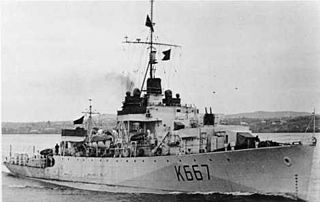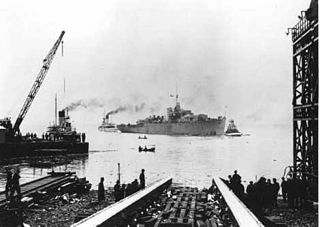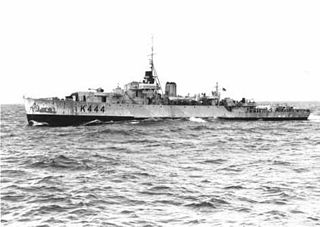
HMCS Eastview was a River-class frigate that served in the Royal Canadian Navy from 1944-1946. She served as a convoy escort in the Battle of the Atlantic. She was named after the Ottawa suburb of Eastview.

HMCS Stormont is a former River-class frigate that served in the Royal Canadian Navy during the Second World War. She fought primarily in the Battle of the Atlantic, but saw service in the Arctic Ocean. She was named for Stormont, Ontario. After the war she was turned into the luxury yacht Christina by Greek billionaire Aristotle Onassis. She continues to sail.

HMCS Cap de la Madeleine was a River-class frigate that served in the Royal Canadian Navy from 1944-1945 and as a Prestonian-class frigate from 1954-1965. She saw action in the Battle of the Atlantic as a convoy escort during the Second World War. She is named for Cap-de-la-Madeleine, Quebec, which is now a part of Trois-Rivières.

HMCS Magog was a River-class frigate that served in the Royal Canadian Navy (RCN) during the Second World War. She was used primarily as a convoy escort. On 14 October 1944, she was torpedoed by U-1223. She survived the attack, was towed to port and declared a constructive total loss. Magog was named for the town of Magog, Quebec.

HMCS Kokanee was a River-class frigate that served in the Royal Canadian Navy during the Second World War. She saw action primarily in the Battle of the Atlantic as a convoy escort. After the war she was sold to India and converted into a pilot vessel.

HMCS Charlottetown was a River-class frigate that served with the Royal Canadian Navy (RCN) during the Second World War. She was the second vessel of the name, HMCS Charlottetown having been a Flower-class corvette that had been sunk earlier in the war. They are unique for being the only two ships to have shared the same pennant number, K 244. She was named for Charlottetown, Prince Edward Island.

HMCS Cape Breton was a River-class frigate that served the Royal Canadian Navy (RCN) during the Second World War. She served primarily as a convoy escort in the Battle of the Atlantic during the war. She was named for Cape Breton Island in Nova Scotia. She was the first to carry her name, HMCS Cape Breton was the second.

HMCS Inch Arran was a River-class frigate that served with the Royal Canadian Navy during the Second World War and again from 1954 to 1965, when she was converted into a Prestonian-class frigate. She was named after Inch Arran Point in Dalhousie, New Brunswick, Canada. This was due to the inability of two Allied warships to bear the same name. The RCN would then use landmarks or significant areas that were associated with the community instead.

HMCS Glace Bay was a River-class frigate built for the Royal Canadian Navy (RCN) in 1943. Commissioned in 1944 she served in the Battle of the Atlantic until the end of the Second World War. After the war, she was sold to the Chilean Navy and renamed Esmeralda.

HMCS Swansea was a Canadian River-class frigate that was the most successful U-boat hunter in the Royal Canadian Navy during the Second World War, having a hand in the destruction of four of them. She saw service in the Battle of the Atlantic from 1943 to 1945. Following the war she was refit as a Prestonian-class frigate. She is named for Swansea, Ontario.

HMCS Prestonian was a River-class frigate that served with the Royal Canadian Navy during the Second World War and as a Prestonian-class frigate from 1953–1956. She saw action primarily as a convoy escort. She was named for Preston, Ontario, however due to possible confusion with HMS Preston, her name was altered. In 1956 she began service with the Royal Norwegian Navy as Troll.

HMCS Capilano was a River-class frigate that served with the Royal Canadian Navy during the Second World War. She served primarily as a convoy escort in the Battle of the Atlantic. She is named for the Capilino River in North Vancouver, British Columbia. The navy intended to name the ship after North Vancouver; however, due to possible confusion with HMCS Vancouver, she was named after the lake.

HMCS Chebogue was a River-class frigate that served with the Royal Canadian Navy during the Second World War. She served primarily as an ocean convoy escort in the Battle of the Atlantic. She was named for Chebogue, Nova Scotia. During the war she was torpedoed and declared a constructive loss.

HMCS Joliette was a River-class frigate that served with the Royal Canadian Navy during the Second World War. She served primarily as a convoy escort in the Battle of the Atlantic. She was named for Joliette, Quebec. After the war she was transferred to the Chilean Navy in 1946 and renamed Iquique. She served with the Chilean Navy until 1968.

HMCS Valleyfield was a River-class frigate that served with the Royal Canadian Navy during the Second World War. She served primarily as a convoy escort in the Battle of the Atlantic. She was torpedoed and sunk in May 1944, the only River-class frigate lost by the RCN. She was named for Salaberry-de-Valleyfield, Quebec.

HMCS LaSalle was a River-class frigate that served with the Royal Canadian Navy during the Second World War. She served primarily as a convoy escort in the Battle of the Atlantic and in the Battle of the St. Lawrence. She was named for LaSalle, Quebec.

HMCS St. Catharines was a River-class frigate that served with the Royal Canadian Navy during the Second World War. She served primarily as a convoy escort in the Battle of the Atlantic. She was named for St. Catharines, Ontario. After the war she was re-purposed as a weather ship for use by the Department of Transport of Canada.

HMCS Matane was a River-class frigate that served with the Royal Canadian Navy during the Second World War. She served primarily as a convoy escort in the Battle of the Atlantic. She was named for Matane, Quebec.

HMCS Wentworth was a River-class frigate that served with the Royal Canadian Navy during the Second World War. She served primarily as a convoy escort in the Battle of the Atlantic. She was named in honour of the town of Dartmouth, Nova Scotia. She could not be named HMCS Dartmouth for fear of confusion with HMS Dartmouth, and so was named after a famous early resident, Nova Scotia Lieutenant Governor Sir John Wentworth. Her name is often mistakenly associated with Wentworth County, Ontario, in honour of the city of Hamilton.

HMCS Waskesiu was a River-class frigate of the Royal Canadian Navy. The frigate served as a convoy escort in the Battle of the Atlantic during the Second World War. It was the first frigate constructed and commissioned into the Royal Canadian Navy. Following the war, the vessel was sold to India where it was renamed Hooghly. Named after the town of Prince Albert, Saskatchewan, there was already a warship named "Prince Albert". The Royal Canadian Navy then named the ship after the town closest to Prince Albert National Park.






















